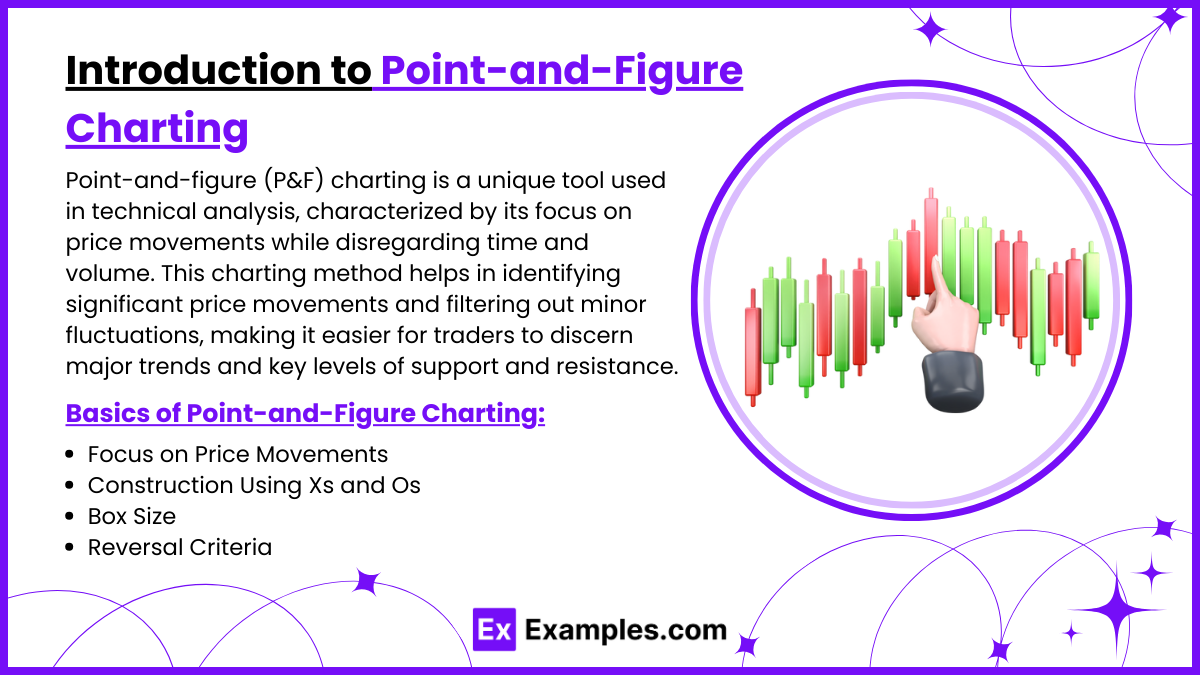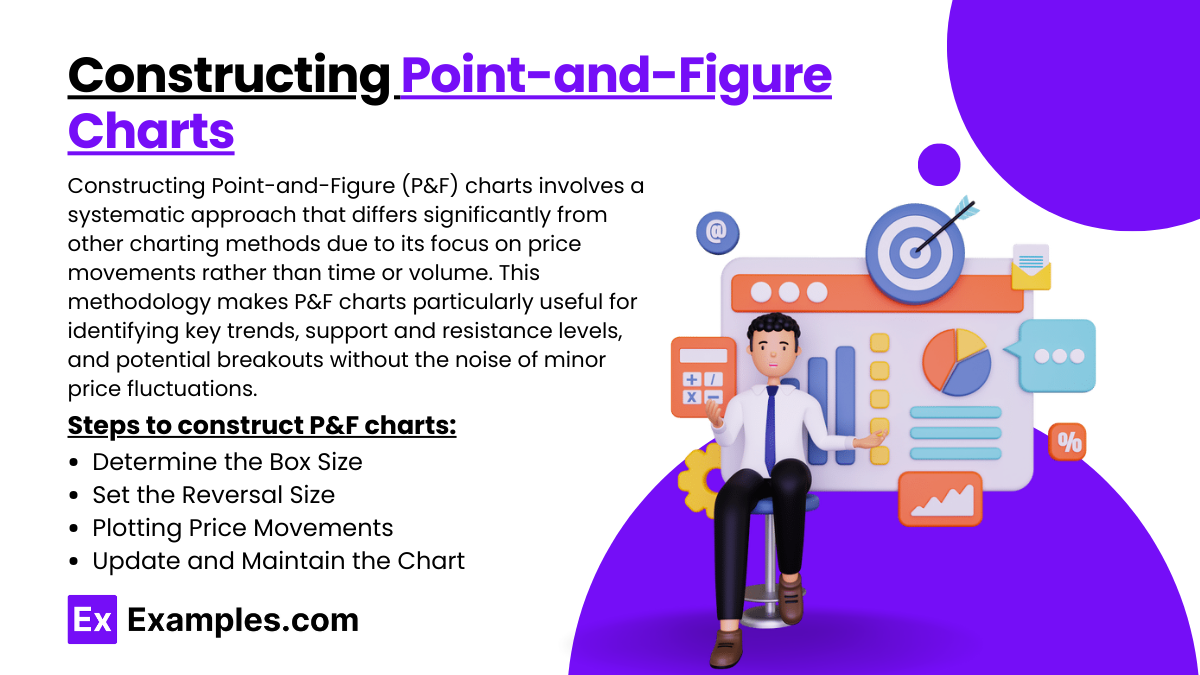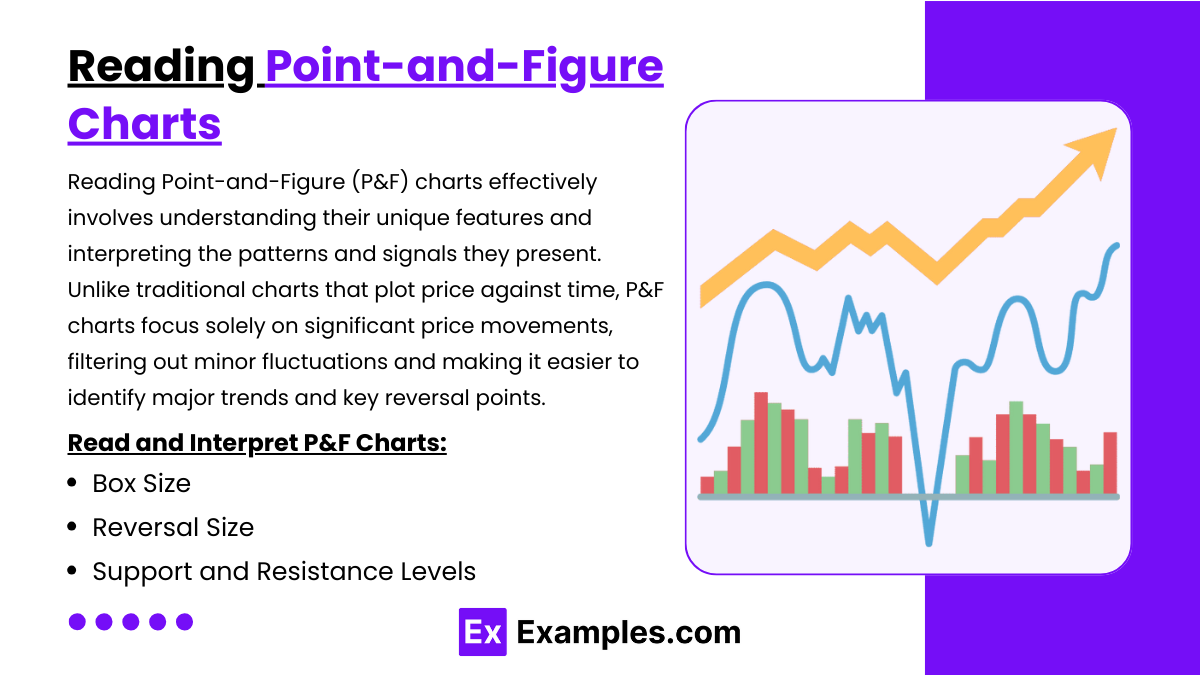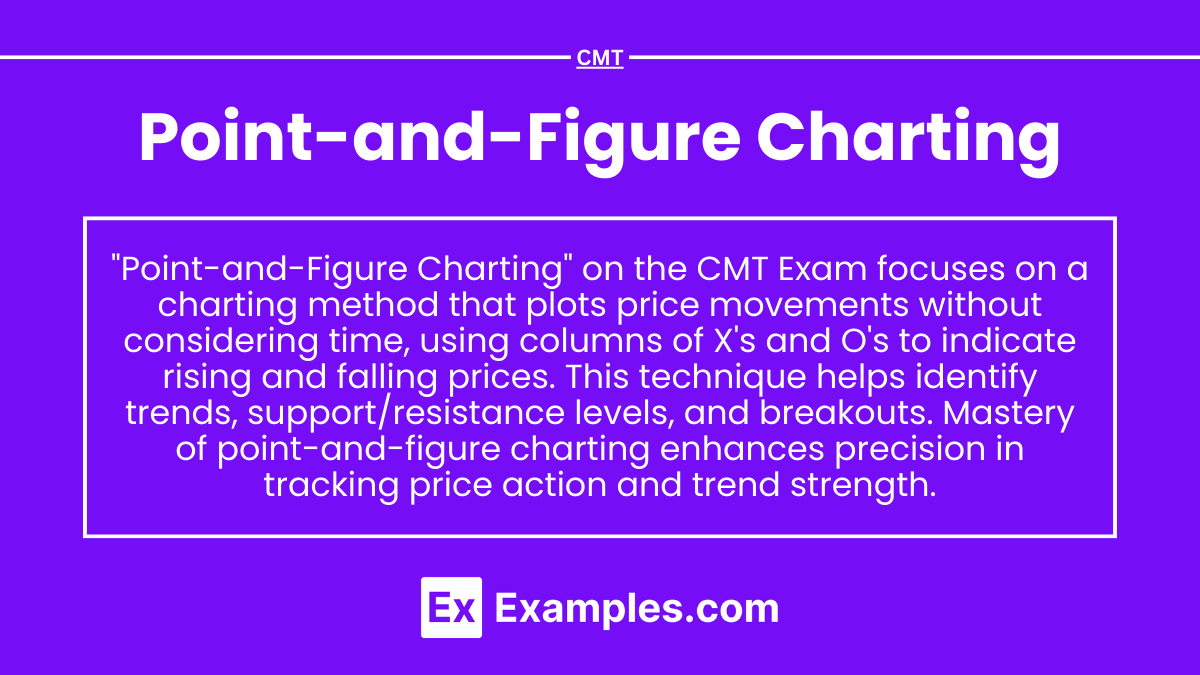Preparing for the CMT Exam requires a comprehensive understanding of “Point-and-Figure Charting,” a crucial component of technical analysis. Mastery of point-and-figure techniques helps identify supply and demand dynamics and price movements. This knowledge provides insights into trend continuations and reversals, critical for achieving a high CMT score.
Learning Objective
In studying “Point-and-Figure Charting” for the CMT Exam, you should learn to understand the unique methodology behind point-and-figure charting as a tool for technical analysis. Analyze how this charting technique helps identify significant price movements, eliminating minor fluctuations that often contribute to noise. Evaluate the principles behind constructing point-and-figure charts, including the determination of box size and reversal criteria. Additionally, explore how these charts are used to detect patterns that indicate breakouts, support and resistance levels, and potential trend reversals. Apply this knowledge to develop trading strategies that utilize point-and-figure charting to capture and capitalize on market trends effectively.
Introduction to Point-and-Figure Charting

Point-and-figure (P&F) charting is a unique tool used in technical analysis, characterized by its focus on price movements while disregarding time and volume. This charting method helps in identifying significant price movements and filtering out minor fluctuations, making it easier for traders to discern major trends and key levels of support and resistance. Here’s an introduction to the fundamentals of point-and-figure charting:
Basics of Point-and-Figure Charting:
- Focus on Price Movements: P&F charts are solely concerned with price changes and do not account for the passage of time or trading volume. This focus helps eliminate the noise of insignificant fluctuations and highlights significant trends.
- Construction Using Xs and Os:
- X-Columns: Represent rising prices. Each “X” in the column denotes a set amount of price increase, known as the box size.
- O-Columns: Indicate falling prices. Each “O” reflects a decrease in price by the box size.
- Box Size: This is a predetermined amount that the price must move for it to be recorded on the chart. The box size setting is crucial as it determines the sensitivity of the chart to price movements.
- Reversal Criteria: Unlike traditional charts, a new column on a P&F chart is started only when there is a price movement opposite to the current column that exceeds a certain threshold, typically three times the box size. This mechanism helps in emphasizing reversals and filtering out less significant price movements.
Constructing Point-and-Figure Charts

Constructing Point-and-Figure (P&F) charts involves a systematic approach that differs significantly from other charting methods due to its focus on price movements rather than time or volume. This methodology makes P&F charts particularly useful for identifying key trends, support and resistance levels, and potential breakouts without the noise of minor price fluctuations. Here’s a step-by-step guide on how to construct P&F charts:
- Determine the Box Size:
- Definition: The box size is the minimum price movement required to add a mark on the chart.
- Selection: Choose a fixed amount, a percentage, or use a volatility-based measure like the Average True Range (ATR) to set the box size. Smaller box sizes capture more detail, while larger sizes filter out minor movements.
- Set the Reversal Size:
- Definition: The reversal size is the amount the price must move in the opposite direction to switch from Xs to Os or vice versa.
- Common Setting: Typically set at three times the box size to emphasize significant price reversals and avoid noise.
- Plotting Price Movements:
- Rising Prices: Mark an “X” for each box size increase in price.
- Falling Prices: Mark an “O” for each box size decrease when the price drops by the reversal size from the last recorded price.
- Update and Maintain the Chart:
- Column Switch: Start a new column when the price moves in the opposite direction of the current column by the full reversal amount.
- Continuation: Continue adding Xs or Os in the existing column as long as the price moves in the same direction by at least one box size.
Reading Point-and-Figure Charts

Reading Point-and-Figure (P&F) charts effectively involves understanding their unique features and interpreting the patterns and signals they present. Unlike traditional charts that plot price against time, P&F charts focus solely on significant price movements, filtering out minor fluctuations and making it easier to identify major trends and key reversal points. Here’s a guide on how to read and interpret P&F charts:
- Box Size:
- The box size determines the sensitivity of the chart. A smaller box size captures smaller price changes, making the chart more sensitive and detailed, while a larger box size filters out more noise, focusing on more significant trends.
- Reversal Size:
- This is the minimum amount that the price must move in the opposite direction to warrant a change in the column from Xs to Os or vice versa. This setting helps distinguish between normal market fluctuations and actual reversals.
- Support and Resistance Levels:
- Horizontal rows of Xs or Os can indicate strong areas of support or resistance. Support levels are often identified at the bottom of O columns where a reversal to Xs occurs, indicating buying interest. Resistance levels are identified at the top of X columns where a reversal to Os occurs, indicating selling pressure.
Chart Patterns in Point-and-Figure Charting

Point-and-Figure (P&F) charting is distinguished by its focus on price movements rather than time or volume, simplifying the identification of key trends and reversal signals through the use of chart patterns. These patterns help traders anticipate potential breakouts or breakdowns, providing actionable trading insights. Here’s an overview of some common chart patterns in Point-and-Figure charting:
Key P&F Chart Patterns:
- Double Top and Double Bottom
- Double Top: Forms when two columns of Xs reach the same height, signaling resistance. A breakout below the intervening lows (column of Os) suggests a bearish reversal.
- Double Bottom: Occurs when two columns of Os reach the same low, indicating support. A breakout above the intervening highs (column of Xs) suggests a bullish reversal.
- Triple Top and Triple Bottom
- Triple Top: More significant than a double top, this pattern features three attempts to break through a resistance level, each separated by pullbacks. A subsequent fall below the lowest pullback signals a strong bearish move.
- Triple Bottom: Inverse of the triple top, indicating a strong support level with three touches. A rise above the highest pullback column indicates a bullish breakout.
- Catapult Patterns
- Bullish Catapult: A strong bullish signal where a double top breakout is followed by a consolidation and another breakout, confirming a robust uptrend continuation.
- Bearish Catapult: Involves a double bottom breakdown followed by a consolidation and another breakdown, confirming a strong downtrend continuation.
- Ascending and Descending Triple Tops
- Ascending Triple Top: Successive columns of Xs create progressively higher peaks, suggesting an increasing bullish sentiment and potential breakout.
- Descending Triple Bottom: Successive columns of Os mark progressively lower troughs, indicating strengthening bearish momentum and potential breakdown.
- Long Tail Down
- A lengthy column of Os reflects a sharp price drop, which, if followed by a reversal marked by a column of Xs, may indicate strong support and a potential bullish reversal opportunity.
Examples
Example 1: Detecting Breakouts in Equity Markets
A point-and-figure chart of a tech company’s stock shows a series of X columns surpassing a previously established resistance level. This pattern signals a breakout, indicating a strong buy opportunity as the price action suggests continued upward momentum.
Example 2: Identifying Reversals in Forex Trading
In a currency pair such as EUR/USD, a point-and-figure chart displays a prolonged column of Os, followed by a reversal that produces three consecutive columns of Xs surpassing the previous high. This change indicates a bullish reversal, offering a strategic entry point for long positions.
Example 3: Support and Resistance Levels in Commodities
For a commodity like gold, point-and-figure charting identifies clear support levels as zones where multiple O columns fail to move lower past a certain price point. Traders use these levels as indicators for placing buy orders or setting stop-loss levels.
Example 4: Consolidation Detection in Indices
A point-and-figure chart of an index like the S&P 500 shows a series of alternating X and O columns within a tight price range, signifying market consolidation. Traders might wait for a breakout beyond this range to confirm a new trend direction before making significant trading decisions.
Example 5: Portfolio Diversification Analysis
A portfolio manager uses point-and-figure charts to evaluate various asset classes’ performance and volatility. By recognizing patterns and trends specific to each asset, the manager can better allocate investments, minimizing risk and maximizing returns based on clear, visually represented market data.
Practice Questions
Question 1
What does a column of Xs represent in a point-and-figure chart?
A. A significant drop in prices
B. A consolidation phase
C. A rising price trend
D. Indecision in the market
Answer:
C. A rising price trend
Explanation:
In point-and-figure charting, a column of Xs represents an upward price movement, indicating a rising trend. Each X marks a specific price increment above the previous column, showing bullish momentum in the asset’s price.
Question 2
Which point-and-figure chart feature helps identify support and resistance levels?
A. The length of the X and O columns
B. The reversal criteria set
C. Horizontal count method
D. The box size
Answer:
C. Horizontal count method
Explanation:
The horizontal count method in point-and-figure charting is used to determine the potential price targets and identify significant support and resistance levels by measuring the width of congestion areas formed by columns of Xs and Os. This method provides a quantitative way to forecast price movements based on the chart patterns.
Question 3
What is the significance of a reversal in a point-and-figure chart?
A. Indicates a change in market volatility
B. Confirms the continuation of the current trend
C. Signals a potential change in the trend direction
D. Represents a permanent shift in market dynamics
Answer:
C. Signals a potential change in the trend direction
Explanation:
A reversal in a point-and-figure chart, indicated by switching from a column of Xs to a column of Os or vice versa, signals a potential change in the trend direction. This reversal is significant as it suggests a shift in market sentiment and often precedes major trend changes, providing traders with insights to adjust their positions accordingly.


